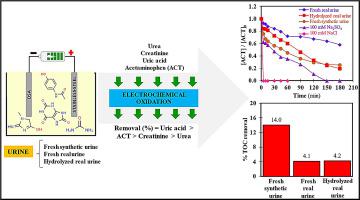当前位置:
X-MOL 学术
›
Water Res.
›
论文详情
Our official English website, www.x-mol.net, welcomes your
feedback! (Note: you will need to create a separate account there.)
Electrochemical degradation of acetaminophen in urine matrices: Unraveling complexity and implications for realistic treatment strategies
Water Research ( IF 11.4 ) Pub Date : 2024-07-02 , DOI: 10.1016/j.watres.2024.122034 Raul José Alves Felisardo 1 , Enric Brillas 2 , Treavor H Boyer 3 , Eliane Bezerra Cavalcanti 4 , Sergi Garcia-Segura 3
Water Research ( IF 11.4 ) Pub Date : 2024-07-02 , DOI: 10.1016/j.watres.2024.122034 Raul José Alves Felisardo 1 , Enric Brillas 2 , Treavor H Boyer 3 , Eliane Bezerra Cavalcanti 4 , Sergi Garcia-Segura 3
Affiliation

|
Urine has an intricate composition with high concentrations of organic compounds like urea, creatinine, and uric acid. Urine poses a formidable challenge for advanced effluent treatment processes following urine diversion strategies. Urine matrix complexity is heightened when dealing with pharmaceutical residues like acetaminophen (ACT) and metabolized pharmaceuticals. This work explores ACT degradation in synthetic, fresh real, and hydrolyzed real urines using electrochemical oxidation with a dimensional stable anode (DSA). Analyzing drug concentration (2.5 - 40 mg L−1 ) over 180 min at various current densities in fresh synthetic effluent revealed a noteworthy 75% removal at 48 mA cm−2 . ACT degradation kinetics and that of the other organic components followed a pseudo-first-order reaction. Uric acid degradation competed with ACT degradation, whereas urea and creatinine possessed higher oxidation resistance. Fresh real urine presented the most challenging scenario for the electrochemical process. Whereas, hydrolyzed real urine achieved higher ACT removal than fresh synthetic urine. Carboxylic acids like acetic, tartaric, maleic, and oxalic were detected as main by-products. Inorganic ionic species nitrate, nitrite, and ammonium ions were released to the medium from N-containing organic compounds. These findings underscore the importance of considering urine composition complexities and provide significant advancements in strategies for efficiently addressing trace pharmaceutical contamination.
中文翻译:

尿液基质中对乙酰氨基酚的电化学降解:揭示复杂性及其对现实治疗策略的影响
尿液的成分复杂,含有高浓度的有机化合物,如尿素、肌酐和尿酸。尿液对遵循尿液分流策略的先进废水处理工艺提出了巨大的挑战。处理对乙酰氨基酚 (ACT) 和代谢药物等药物残留物时,尿液基质的复杂性会增加。这项工作利用尺寸稳定阳极 (DSA) 进行电化学氧化,探索了合成尿液、新鲜真实尿液和水解真实尿液中 ACT 的降解。在 180 分钟内以不同电流密度分析新鲜合成流出物中的药物浓度 (2.5 - 40 mg L−1) 后发现,在 48 mA cm−2 下,去除率高达 75%。 ACT 降解动力学和其他有机成分的降解动力学遵循伪一级反应。尿酸降解与ACT降解竞争,而尿素和肌酐具有更高的抗氧化性。新鲜的真实尿液对电化学过程来说是最具挑战性的场景。然而,水解真实尿液比新鲜合成尿液实现了更高的 ACT 去除率。检测到的主要副产物是乙酸、酒石酸、马来酸和草酸等羧酸。无机离子物质硝酸根、亚硝酸根和铵离子从含氮有机化合物释放到介质中。这些发现强调了考虑尿液成分复杂性的重要性,并为有效解决微量药物污染的策略提供了重大进展。
更新日期:2024-07-02
中文翻译:

尿液基质中对乙酰氨基酚的电化学降解:揭示复杂性及其对现实治疗策略的影响
尿液的成分复杂,含有高浓度的有机化合物,如尿素、肌酐和尿酸。尿液对遵循尿液分流策略的先进废水处理工艺提出了巨大的挑战。处理对乙酰氨基酚 (ACT) 和代谢药物等药物残留物时,尿液基质的复杂性会增加。这项工作利用尺寸稳定阳极 (DSA) 进行电化学氧化,探索了合成尿液、新鲜真实尿液和水解真实尿液中 ACT 的降解。在 180 分钟内以不同电流密度分析新鲜合成流出物中的药物浓度 (2.5 - 40 mg L−1) 后发现,在 48 mA cm−2 下,去除率高达 75%。 ACT 降解动力学和其他有机成分的降解动力学遵循伪一级反应。尿酸降解与ACT降解竞争,而尿素和肌酐具有更高的抗氧化性。新鲜的真实尿液对电化学过程来说是最具挑战性的场景。然而,水解真实尿液比新鲜合成尿液实现了更高的 ACT 去除率。检测到的主要副产物是乙酸、酒石酸、马来酸和草酸等羧酸。无机离子物质硝酸根、亚硝酸根和铵离子从含氮有机化合物释放到介质中。这些发现强调了考虑尿液成分复杂性的重要性,并为有效解决微量药物污染的策略提供了重大进展。











































 京公网安备 11010802027423号
京公网安备 11010802027423号